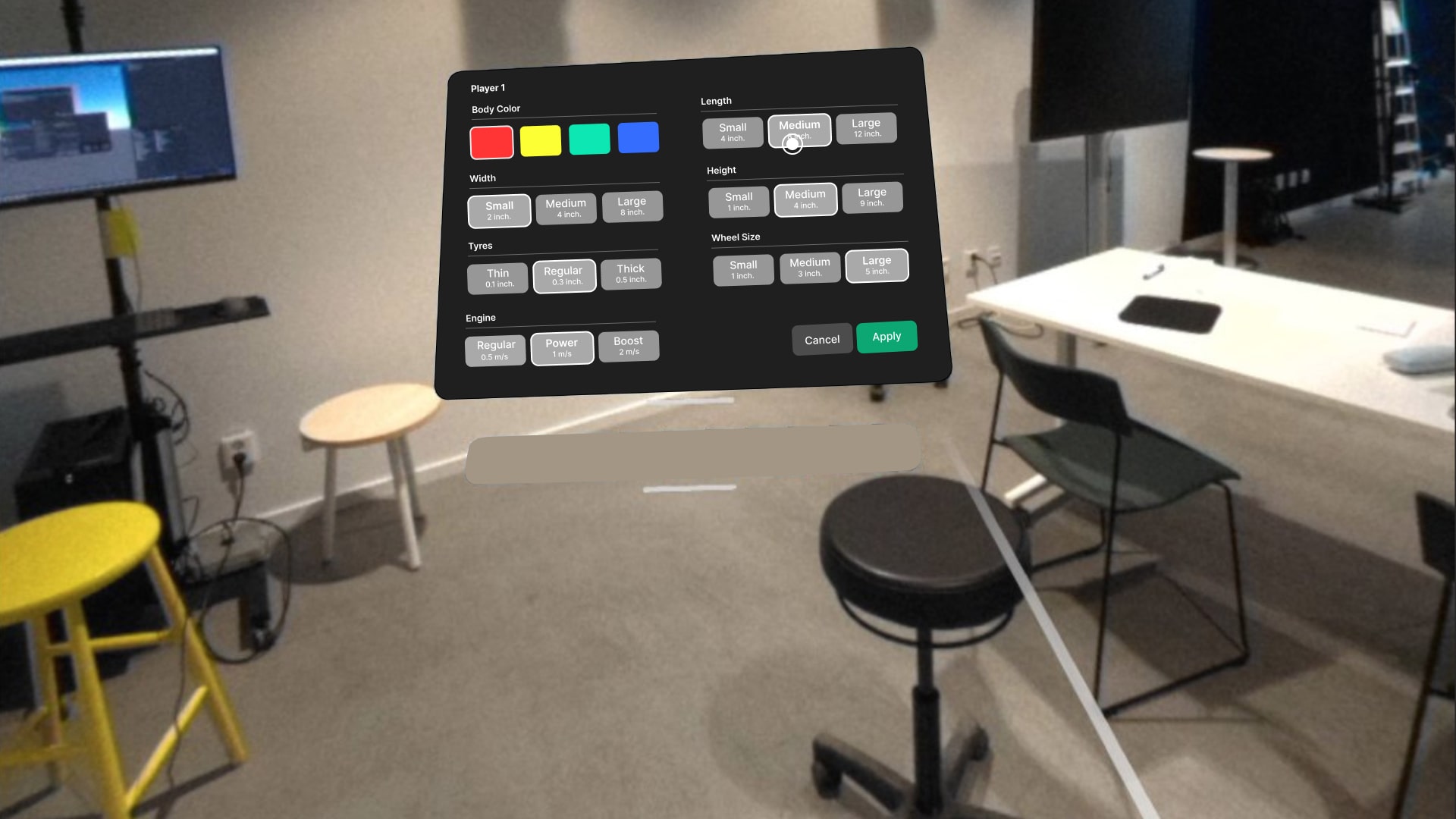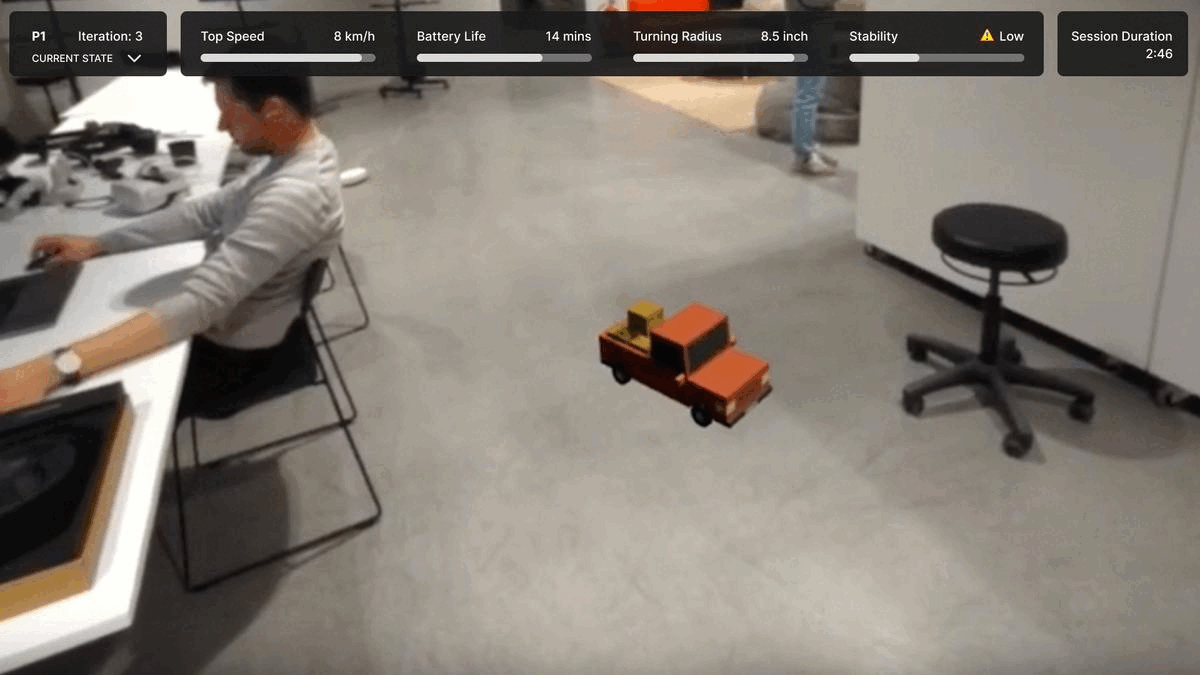Concept
buildMRide is a Mixed Reality(MR) application for prototyping toy car designs.
The purpose of the experience is to allow toy car designers to make and test new iterations of their creation in an MR environment, to evaluate its performance without the need to assemble a physical prototype.
Context and Inquiry
This project was developed during a course called 'Design for Complex and Dynamic Contexts', where the focus was on Digital Twins and MR technology.
Traditional methods of physical prototyping often require materials, tools, labor costs, and the time to create physical prototypes that can be very expensive (Leng et al. 2021). The process of
design usually requires “physical prototypes to be assembled to check and verify whether the virtual space model is accurately matched, including structure, ergonomics, and performance indexes” (Leng et al. 2021).
The manufacturing of physical models can be very expensive (Leng et al. 2021). In this case modeling digital prototypes could be a good solution (Leng et al. 2021). One of the solutions can be a digital twin as “a
digital prototype is a kind of rehearsal in which the information model replaces physics” (Leng et al. 2021). Some previous research showed that DT’s of the toys such as modeling ships could “create simulations that
can be easily accessed and executed” (Fonseca et al. 2020).
Our team's objective was - How can MR based digital twins be useful for toy car designers?
Due to resource limitations, our team proceeded with certain assumptions of altering basic aspects of a toy car with respect to its digital twin, such that this initial prototype can be used as a proof of concept for toy car designers, for testing the car's behavior.
Challenges
We came across various types of challenges, and a few of the important ones are given below:
Technology
- How to develop a manipulatable model?
- How to incorporate a collaborative experience?
- How to change the vehicle's behavior, to simulate physics?
Interactions and Interface
- What aspects of the vehicle are modified?
- How to indicate the changed features?
- How to manipulate and control the vehicle's properties?
Application
- What aspects of the vehicle should be manipulatable?
- What features will be most impactful?
- How does this application communicate a digital twin?
Technology and Tools
buildMRide was developed using the Unity game engine and the Oculus Integration SDK. Figma was used for prototyping interfaces.


Interactions
The interactions were mainly controller based. Due to the complexity of interactions available, using hand-tracking was dropped.
The left controller was used for the customization of the vehicle. The right controller was used for driving controls and respawning of the vehicle.
Using controllers, also provided haptic feedback when the car collided with the obstacles.


Timeline, Team and Mentors
The project was researched, conceptualised and prototyped between 28 March 2023 to 31 May 2023.
We were a team of 5 members; Elias L, Karan D (self), Kiran S, Maria D and Siyue L.
My contributions to the team were in the research, concept development, design of the MR interface and interactions, the user experience, project's branding and communication.
The project was mentored by Prof. Jordi Solsona Belenguer, Prof. Asreen Rostami, Patricia Ciobanu, Jonas Collin and Paul Victor Vinegren.
Outcome
The project received an overall positive feedback, with scope for improvement in the features and functionalities. Given below are some of the comments received:
- There can be more data visualisation.
- Place virtual objects more towards the center of the environment.
- It's good to interact with other's car.
- The project is easier to understand.
- If the user is younger, add more images.
- Bring the obstacles for testing, closer to the user.
- The cars remind me of Lego.
- Sometimes I cannot find the car, so there can also be a way to bring it back.
Learnings
My take-aways were:
- For proof-of-concept prototypes, a show/hide toggle based UI manual can help the onboarding.
- User controls can be presented when necessary as controller based interactions are still new to many.
- User testing at an early stage, should be incorporated, when possible.
- Collaborative or Multi User, Mixed Reality applications can take longer to prototype.
- Different users have different; head-eye movements, and hand-eye coordination.
References
- Fonseca, Í. A., Gaspar, H. M. (2020) Fundamentals Of Digital Twins Applied To A Plastic Toy Boat And A Ship Scale Model. ECMS, 207-213. Available from: auth3in.doc (researchgate.net) (Accessed: 2023-04-02)
- Leng, J., Wang, D., Shen, W., Li, X., Liu, Q., Chen, X. 2021. Digital twins-based smart manufacturing system design in Industry 4.0: A review. Journal of manufacturing systems, 60, 119-137. https://doi.org/10.1016/j.jmsy.2021.05.011
Full report of this project is available on this link.